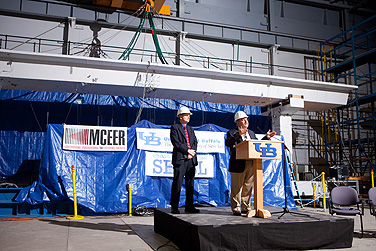News
‘Quake’ tests new bridge construction

Amjad Aref (at podium) and Andre Filiatrault discuss the results of the test after the simulated earthquake. Photo: DOUGLAS LEVERE
The major earthquake that “struck” a 70-ton, 60-foot-long concrete bridge on Tuesday in UB’s Structural Engineering and Earthquake Simulation Laboratory will help engineers evaluate if a fast, new construction method results in bridges strong enough to withstand seismic activity.
The test, conducted by earthquake engineers in the Department of Civil, Structural and Environmental Engineering and MCEER (formerly the Multidisciplinary Center for Earthquake Engineering Research), was the largest earthquake—simulated or otherwise—to hit a bridge constructed using the rapid and cost-effective method called Accelerated Bridge Construction (ABC).
The project is funded by the Federal Highway Administration (FHWA).
The results could usher in a new era in bridge construction for seismic areas, such as California.
Data from the UB-MCEER tests will be used by FHWA to begin to develop standards for getting the best performance from ABC in seismically active areas.
Tuesday’s two tests were conducted on the half-scale bridge, which had been erected across UB’s twin shake tables.
The Structural Engineering and Earthquake Simulation Laboratory, with its twin, relocatable shake tables, is one of the few places in the world that could perform this kind of test. It demonstrates the unique ability of UB and MCEER to develop and evaluate technological innovations that are increasingly critical in addressing the nation’s aging infrastructure—especially advances that can save time and money.
Hundreds of bridges have been built around the nation using this speedy new construction method in which the components are prefabricated in a shop, then transported to the site, where they are assembled.
It’s so fast that it can take just days, not months, to build a bridge, saving states and municipalities precious public dollars.
But how will such bridges perform in California or other seismically active regions?
“The concern is that these bridges are basically concrete boxes held together by steel tendons (cables), which potentially could snap during an earthquake,” says Andre Filiatrault, professor of civil, structural and environmental engineering and director of MCEER. He and Amjad Aref, also a civil engineering professor at UB, are principal investigators. Myrto Anagnostopoulou, UB structural and test engineer, and Petros Sideris, a UB doctoral student in civil, structural and environmental engineering, are members of the project team.
They note that the bridge piers and deck consist of segments connected by tendons or joints, and that if they were to break apart, there would be nothing to hold the bridge components intact.
However, these same tendons may account for the excellent performance the UB researchers have been seeing in the lab.
“You could think of the deck and piers as held together by elastic bands,” says Filiatrault. “The elements deform under seismic loading, and then re-center themselves after the earthquake is over.”
For the past two weeks, Aref, Filiatrault and colleagues have been subjecting the bridge to increasingly powerful earthquakes. Tuesday, it underwent its most powerful seismic tests.
“It can take six months or more to construct a bridge in the traditional way,” says Aref. “If you could reduce that to just a few days, states and cities could save millions in labor costs.”
At the same time, he says, it will give communities that have lost use of their bridges after an extreme event a new tool in rebuilding quickly and economically.
“After a disaster, quick reconstruction is even more critical,” Aref says.


Reader Comments